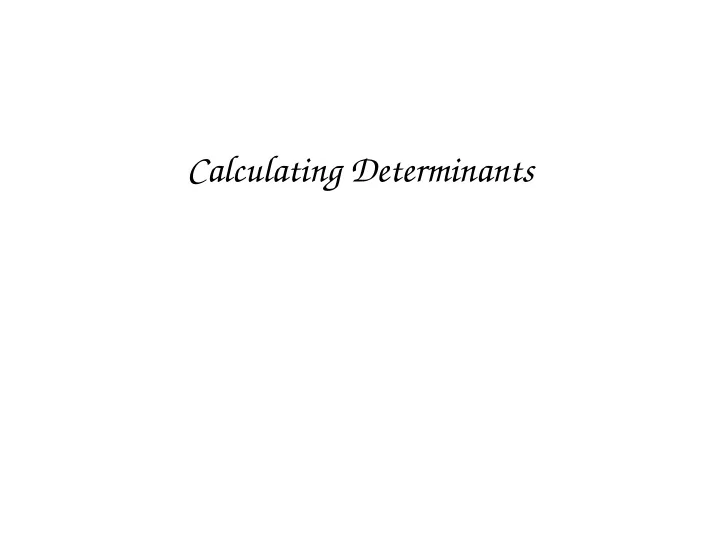

Calculating Determinants
Recursive Formula: Cofactor Expansion Assume A is n × n matrix. Let A ij de- Fact. note the matrix formed by removing row i and column j . Then expansion across the first row of A gives the formula det A = a 11 det A 11 − a 12 det A 12 + . . . +( − 1) 1+ n a 1 n det A 1 n One can expand across other rows, but note that the sign is always ( − 1) i + j . Each term C ij = ( − 1) i + j A ij in the expansion is called a cofactor . detTWO: 2
Example Cofactor Expansion The matrix 3 6 0 2 7 − 1 0 4 − 8 has determinant � � � � � � 7 − 1 2 − 1 2 7 � � � � � � 3 � − 6 � + 0 � � � � � � 4 − 8 0 − 8 0 4 � � � � = 3 × ( − 52) − 6 × ( − 16) + 0 = − 60 . detTWO: 3
Elementary Row Operations and Determinants ≻ Adding a multiple of a row to another Fact. row does not change det ≻ Interchanging two rows flips the sign of det ≻ Multiplying a row by a scalar does the same to det detTWO: 4
Calculating Determinants by Reduction ALGOR If one obtains pivots in every row/column when reducing A to echelon form, without using an interchange, then the deter- minant of A is the product of the pivots. detTWO: 5
Example Calculation The matrix 3 6 0 2 7 − 1 0 4 − 8 reduces to 3 6 0 0 3 − 1 0 0 − 20 / 3 without interchanges. Thus the determinant is 3 × 3 × ( − 20 / 3) = − 60 . detTWO: 6
More Properties det( A T ) = det A Fact. det( AB ) = (det A )(det B ) detTWO: 7
Determinants as Volume The volume/area of a box whose sides are vec- tors is given by the absolute value of the associ- ated determinant. For example, area of parallelogram determined by vectors ( x 1 , y 1 ) and ( x 2 , y 2 ) is | x 1 y 2 − x 2 y 1 | . In R 2 , if one applies a matrix transform Fact. M to some shape, then the area of the shape changes by a factor of det M . detTWO: 8
Summary A determinant can be calculated by cofactor ex- pansion. Expansion across the first row says the determinant is the sum of the entry times the determinant of the matrix that remains when that row and column is deleted, with signs al- ternating. Adding a multiple of a row to another row does not change det , interchanging two rows flips the sign of det , and multiplying a row by a scalar does the same to det . detTWO: 9
Summary (cont) If one obtains pivots in every row/column when reducing to echelon form, without using an in- terchange, then the determinant is the product of the pivots. The determinant of the transpose is the same as that of the original. The determinant of the product is the product of the determinants. If one applies a matrix transform M to some shape, then the area of the shape changes by a factor of det M . detTWO: 10
Recommend
More recommend